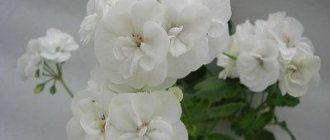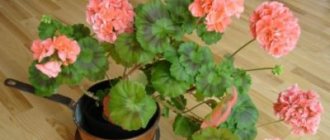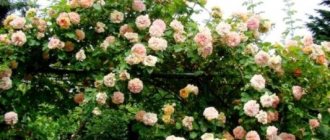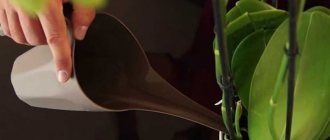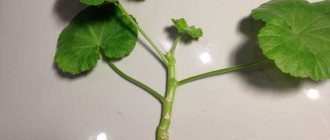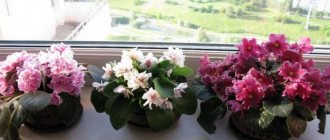Geranium is a very bright, beautifully blooming decoration for any home or apartment. This flower is very popular among both professional flower growers and ordinary amateurs. But despite all its unpretentiousness and ease of care for this plant, for frequent and lush flowering it needs timely and correct pinching of geraniums. Why is it needed and how to do it correctly? How to achieve a lush crown, we will consider further.
Why and when is pinching needed?
Geranium, or as it is also called pelargonium, is a perennial plant that blooms long and luxuriantly. The flower has many medicinal properties and is practically not afraid of insect pests, which it repels with its specific smell. We find geraniums not only in gardens and flower beds, but also on many window sills. Thanks to its unpretentiousness and beautiful flowering, geranium has gained great popularity in our country. But so that this beautiful flower remains compact and attractive. And it didn’t take up half the window sill; it needs to be properly looked after, pinched and trimmed in a timely manner. By using these simple geranium shaping techniques, you will achieve two important goals:
Using hedgehogs to process potatoes
Types of seedling cassettes and their use
Hazelnut - how it grows and blooms, growing a nut in the garden
- Timely pinching will allow the plant to bloom beautifully and profusely.
- In addition, pruning and pinching pelargonium will rid the plant of diseased and weak branches that slow down the growth and development of the flower.
- Pinching delays the flowering period of geraniums, since the nutrients that should be supplied to the upper growth point are spent on the formation of new side shoots. Therefore, this procedure can be used as a regulator of the flowering time of a flower. You need to stop pinching the plant after it has acquired the desired shape and bushiness.
What is it and why is it needed?
Pinching is the removal of the upper growth point of a shoot mechanically in order to stimulate the growth of lateral layers, increase volume and bushiness.
- You can carry out the process with your hands, removing the upper part of the shoot, with small scissors or a sharp blade.
- A correctly carried out process will allow you to get not only a beautiful, compact bush, but also long-term abundant flowering.
- To put it simply, the top of the geranium stem is cut off, which is responsible for its upward growth.
- After this procedure, all the plant’s forces are directed to awakening the dormant buds that are located in the internodes. As a result, the main stem becomes branched.
- Pinching is carried out during the active growing season several times a month until the plant acquires a certain shape conceived by the owner.
- In most cases, the leaves are removed from the stem, leaving 4-6 of the largest and strongest.
You can remove the growth point from the shoot at any time, except in winter - at this time the dormant period begins.
Methods for pruning geraniums
There are three ways to trim:
- main;
- topping;
- autumn
The main procedure is carried out in order to obtain abundant, lush flowering and form a beautiful bush. Autumn pruning is preventative. Pinching is carried out as needed.
Pelargonium should not be injured during flowering - shoots cut during this period are unlikely to be useful for reproduction, and the plant itself will have difficulty healing the cuts. It is better to form the crown of the bush after flowering, so as not to risk the health of your favorite flower.
Preparing tools
Before preparing tools for pinching, you need to understand why and why we are doing this? What is the importance of pruning and pinching? Wondering why geraniums stretch? If you follow all the recommendations and rules, then methodical pruning of pelargonium started on time will:
- Cause shoots to appear on the sides.
- Form new inflorescence primordia.
- Give the flower a neat, even shape.
- Make the flowering period longer and more stable, and the flowering itself more luxuriant.
- Help obtain high-quality planting materials for plant propagation.
Don't expect the side stem to elongate in a season or two. The peculiarity of geranium is that this flower very rarely produces side shoots without human intervention, although each node contains dormant buds. Trimming the flower actually helps these buds to awaken and form new shoots, as well as to lay flower buds.
Now you can directly begin preparing the tools.
- To carry out the procedure, we will need manicure scissors; if we don’t have any, then take a paper knife; it has a thin blade, which is great for removing excess hair.
- Be sure to disinfect the material. Simple alcohol removes germs perfectly. If you don’t have it at hand, then use hydrogen peroxide as an alternative, which will also do the job well.
- It is possible to pinch by hand, but it will be more accurate if you have the proper tool.
- Sharpen the tool so as not to unnecessarily injure the plant.
- When pinching with nails, without special equipment, you should not pull the shoot too hard, because this will harm the plant.
What is the difference between pinching geraniums and pruning?
Pinching is the removal of the point from which a new branch grows. In other words, you just need to cut off the top of the pelargonium stem. Flower growers called pinching “tear off the top.” Thanks to this procedure, young shoots develop from the trunk, thereby the branching of pelargonium gradually increases. Geraniums are usually pinched either in February or March. Some gardeners also recommend pruning the plant in the fall.
How to prune geraniums in autumn and spring
After the completion of the phase of ejection of peduncles with the gradual withering of existing inflorescences, the time comes for autumn pruning, the purpose of which is not only to form a bush, but also to improve the health of the entire plant.
For this:
- Faded inflorescences, dried or injured shoots are removed, which weaken the plant, preventing new branches from developing.
- Then the elongated, weakened and leafless shoots, which reduce the decorative qualities of the flower, are cut off by ⅓.
- Pruning geraniums in the fall can be done until December, after which the flower is left alone: during the period with short daylight hours, the crop is most vulnerable, and any external influence is stressful for it.
Why do geraniums need a haircut?
Every spring we can see how bushes and trees are trimmed on the central streets of the city, giving them the correct shape. But few people realize that this haircut is not only decorative. Plants are pruned to improve the health and rejuvenation of the crown. The same applies to indoor specimens prone to intensive growth, such as pelargonium (geranium).
Purpose and benefits of pruning
The main purpose of pruning any plant is to thin the crown to improve air exchange, lighting and leaf nutrition. Without this event, the geranium will have a neglected and unhealthy appearance, will stop blooming, and will turn into a shapeless and unkempt bush.
What are the benefits of pruning geraniums:
- flowering period is extended;
- metabolism accelerates and its quality improves;
- more lateral branches and young shoots are formed;
- wintering becomes easier.
The flowering time of geraniums depends on the variety and occurs from early spring to late autumn, and in some varieties even in winter. In order to have a lot of inflorescences on the plant, it is necessary to prune the bush, but do it correctly and in a timely manner, according to the characteristics of the variety.
To form a beautiful bush and lush color, geraniums need regular pruning.
Autumn pruning is a more logical procedure than spring pruning. From November to February, geraniums begin their dormant period. The plant often slows down its development while continuing to feed. In this state it is very difficult to maintain a lush crown, but cutting it makes wintering much easier. Drastic pruning allows pelargonium to refresh the crown and re-form the bush.
If your pelargonium blooms all year round, then you can cut it at any time.
In winter, geraniums can be trimmed only if there are conditions for maintaining the trimmed flower; at least two lower leaves are left. After the crown of the plant has rejuvenated due to radical pruning, its bush can be formed during the winter by pinching and decorative pruning. Zonal pelargonium has the peculiarity of rapid budding and early formation of buds, so it will only be happy to be trimmed;
- ivy-leaved pelargonium can be cut in both spring and autumn. If the bush becomes excessively elongated during the winter, it is trimmed at the end of February - beginning of March;
- Flower growers cut ampelous geraniums at their own discretion; if the plant does not need pruning, then it is not touched until spring;
- the variegated species is difficult to tolerate autumn pruning; it is easier for them to go through such stress in the spring;
- mini-varieties of geraniums are not cut at all. The crown of these tiny pelargoniums is adjusted only for reasons of beauty and decorativeness of the bush;
- Royal pelargonium is trimmed “under the stump” and placed in a cool place. But such a drastic pruning is not done regularly, but only when necessary, because the plant does not develop as intensively as, for example, zonal geranium.
Pinching geraniums
Formation of geraniums from the beginning of development by pinching shows excellent results, the main one of which is the creation of a beautiful bush with minimal intervention.
Pinching petunias for abundant flowering
How to plant Achimenes rhizomes
How to prepare an epin solution for soaking seeds
The procedure is carried out according to the following scheme:
- 2-3 weeks after transplanting a new plant, the apical bud is pinched.
- As the side shoots are pulled out - after the formation of the fourth leaf - another pinching is carried out.
- After the plant acquires the desired shape or bushiness, pinching stops.
How not to harm geraniums when pruning
Pruning geraniums is a simple procedure, especially if you follow the correct sequence and remember the basic needs of the plant, including seasonal ones. Nevertheless, there are times when a bush dies due to rash actions.
The most common mistakes when pruning
A florist needs to know three common mistakes that pelargonium lovers make when pruning:
- If your geranium spends the whole summer outdoors, in the garden or on the balcony, then before autumn pruning it needs to be kept at home for some time. But often amateur flower growers, having brought pelargonium into the house, immediately begin pruning, and then are surprised that it has turned yellow.
- Always clean, rinse and wipe dry the tool after use, and the cutting parts must also be disinfected. If, after pruning a geranium, you introduce an infection without treating the knife, the plant will get sick very quickly, since pruning means a decrease in immunity.
- Often, after drastic autumn pruning, pelargonium trimmed “to resemble a stump” is placed on a lighted windowsill and they begin to water it mercilessly, relying on the fact that natural conditions will do their job. As a result, from excess moisture, the flower develops black stem disease, and simply put, it rots. Watering should be done rarely and little by little, without excessive evaporation from the soil surface and allowing the earthen clod to dry out to a depth of 4–5 cm.
How to do this correctly?
To properly pinch geraniums, you need to do the following:
First of all, you should carefully examine the shoot, which needs to be stopped in growth. The largest bud is found on it - this is the growth point, which is responsible for the active development of the flower. If you do not remove the bud at the top of the stem, it will continue to grow in height, but lateral shoots will not form.- If you find the main bud on the top of the head, gently pinch it with clean hands; if the stem is already woody, you can take small scissors or a stationery knife and cut it. The operation must be carried out carefully so as not to damage the young leaves nearby and not to break the stem.
- It is worth understanding that after a certain time, the main stem will continue to grow upward, but while it adapts, side buds will awaken on it and give off branches.
- To form a bush, you should watch where the buds wake up first. If the shoots begin to grow in the wrong place where you need them, they are removed completely, then the buds you need will begin to produce layering.
In addition, it is worth paying attention to the following nuances:
- The tools that will be used for pinching must be disinfected - it is advisable to use alcohol. In addition, scissors or pruning shears should be sharpened, and it is better to take a new blade for a stationery knife so as not to unnecessarily injure the geranium. Hands should also be sanitized to prevent third-party infection.
- If no tool is used when pinching geraniums, then try not to pull the plant by the shoot, this will injure it and it will take a lot of time to recover.
- Once all procedures are completed, the plant is transferred to a warm, well-lit place. In order for young cuttings to develop well, they need a lot of sunlight and warmth.
- If unhealthy shoots appear on the geranium, they are immediately removed along with a portion of the healthy shoot, approximately 2-4 cm.
- Places of cuts and pinching must be treated with antiseptic agents. This could be brilliant green, wood ash, activated carbon. If this is not done, the plant may get sick or begin to dry out from the cut site.
If you do everything correctly, the geranium will soon delight you with new shoots.
To make it thicker
In order to ultimately get a flowering compact bush on the windowsill, the top bud should be removed from the main shoot.
At the same time , the growth of the plant stops, it begins to gain strength to awaken the lateral growth points . If the stems begin to grow from the bottom of the main stem, they should be removed so that the plant gets a spherical shape.
So as not to grow upward
To stop the growth of geraniums, the upper part of the stem is removed. But sometimes it happens that after this procedure, layering begins to grow at the top of the main stem - they need to be removed.
The shoots that grow along the stem must also be pinched at the top point of growth so that they do not grow higher than the shortened main stem. If buds appear on the flower at this time, they should also be removed immediately, otherwise the side shoots will be thin and weak.
Blossomed luxuriantly
It is worth understanding that only young layerings of geraniums gain color, therefore, to obtain a luxuriantly flowering plant, you need to carry out systematic pinching . 5 leaves are left on the young layer, the rest is removed. On all shortened cuttings, lateral buds will begin to wake up, and as a result, a magnificent plant with a lush, flowering crown will show off on the windowsill.
Pinching a plant grown from seed
If geranium is planted with seeds, then pinching begins as soon as 6-8 pairs of true leaves are formed on the young plant. In addition, only axillary layers that form from the bottom of the main stem should be left on young geraniums. Layers from the top should be ruthlessly removed.
Anyone who grows geranium or is just planning to do so will benefit from our experts’ materials on feeding the flower, including iodine, on choosing soil and pot, as well as how to properly replant and plant the plant.
Standard geranium
Recently, the standard form of the geranium bush has become very popular - the crown is formed in the form of a tall bare trunk, the top of which is crowned by a lush crown, dotted with inflorescences with bright flowers. This shape is achieved using special pruning techniques and is not possible for all varieties of geranium. For a standard tree, it is worth choosing varieties that are large, tall and produce abundant flowering.
The main trunk is exposed, cutting off all the side shoots and tied to a vertical support. In this state, until the required height is reached, usually a meter, the side shoots are removed from the main trunk without touching its tops. When the desired growth is achieved, the upper side shoots are left and pinched, after which the top of the main stem is also pinched.
Caring for a plant is a necessary measure for its long flowering. Unlike many other flowers, geranium is very unpretentious. Don’t be lazy to spend 15 minutes pinching or trimming so that you can enjoy the beauty and aroma of bright pelargonium inflorescences all summer long.
Incorrect pinching - what to do?
When forming a geranium bush, you cannot pinch out all the side shoots at once - the plant will begin to waste energy on restoration and may not gain color for a long time. In addition, if there are many wounds on the bush, it can become very weak and get sick. In addition, all cuts and pinching areas must be treated with an antiseptic. Ideally, on 1 plant you can pinch only 40-50% of the shoots at a time, leaving the rest for next time.
Correctly and timely formation of a geranium bush will undoubtedly help to add the necessary attractive configuration to the plant, create a dense, compact bush, and flowering will be long and rich. It is worth understanding that the more shoots and young shoots a flower has, the more buds are formed. Following the basic rules and tips described above will help you get a beautiful plant on your windowsill that will not leave any passerby indifferent.


